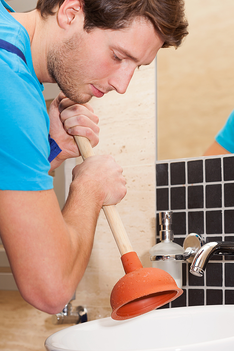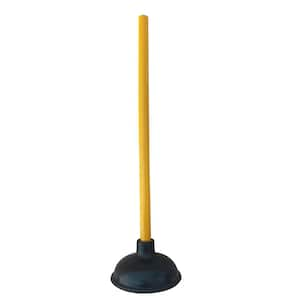Tips to Properly Utilize Plunger and Drain Cleaners: Expert Tips
Tips to Properly Utilize Plunger and Drain Cleaners: Expert Tips
Blog Article
Just about every person maintains their personal rationale about How to Unclog Your Sink with a Plunger.

Intro
Correct maintenance of family drains pipes is vital for preventing obstructions and making certain smooth water circulation. Among the secret tools in every homeowner's toolkit is the bettor, alongside different drainpipe cleansers designed to deal with stubborn clogs effectively. This article discovers exactly how to use plungers and drainpipe cleaners properly to maintain your drains pipes streaming easily.
Area 1: Comprehending Bettors
Sorts of Plungers
There are several kinds of bettors offered, each created for various sorts of drains and clogs. The most typical types include cup bettors, flange bettors, and accordion plungers.
Exactly How Plungers Job
Bettors deal with the principle of developing pressure and suction to dislodge blockages. When appropriately used over a drain, they create a vacuum that can take out particles or separate clogs.
Picking the Right Bettor
Picking the right plunger depends upon the kind of drain and the nature of the blockage. Mug bettors are ideal for sinks and bathtubs, while flange bettors are better fit for commodes as a result of their layout.
Common Mistakes with Plungers
Preventing these errors guarantees reliable plunging: improper seal around the drainpipe, not enough force, and not clearing surrounding particles.
Section 2: Utilizing Plungers Successfully
Preparation
Before plunging, make sure the bettor covers the drain entirely and develops a tight seal. Clear any noticeable debris around the drainpipe opening.
Technique
Begin with mild diving motions to construct suction. Boost stress slowly, utilizing a stable rhythm. Repeat as essential till the drain removes.
Troubleshooting Tips
If diving does not work, try changing the seal, applying oil jelly for a much better seal, or making use of a different kind of plunger.
Area 3: Comprehending Drain Cleaning Company
Kinds Of Drain Cleaning Company
Drain cleansers can be chemical or chemical. Chemical cleaners make use of solid chemicals to dissolve clogs, while chemical cleansers make use of all-natural enzymes to break down organic matter.
Exactly How Drainpipe Cleaning Company Job
Chemical cleaners respond with clogs to dissolve them, while chemical cleansers break down natural materials like hair and grease without hurting pipes.
Security Considerations
Always put on gloves and eye protection when utilizing chemical drainpipe cleaners. Guarantee adequate air flow and comply with supplier guidelines thoroughly.
Eco-Friendly Alternatives
Consider making use of vinegar and baking soda or enzyme-based cleansers for environment-friendly alternatives that are safer for pipelines and the environment.
Area 4: Utilizing Drainpipe Cleansers Efficiently
Application Strategies
Put chemical cleansers directly into the drain opening. Allow them to work for the suggested time before purging with hot water. Enzymatic cleaners must sit overnight.
Precautions
Stay clear of blending different types of cleansers, as this can create toxic fumes. Never ever utilize chemical cleansers combined with a plunger, as spilling can occur.
Taking Care Of Stubborn Clogs
For consistent clogs, consider using a plumbing serpent or calling a specialist plumbing technician to prevent damages to pipelines.
Verdict
To conclude, recognizing just how to make use of bettors and drain cleansers properly is vital for keeping healthy pipes systems. By selecting the right tools and techniques, house owners can deal with small blockages and prevent major plumbing concerns down the line.
How to Use a Plunger to Unclog a Drain
The humble plunger is a simple yet effective tool for breaking clogs in sinks, tubs and toilets. This handy tool is easy to use. You can make the most of its power if you understand how it works. Ready to dive in? Here’s what you need to know.
Safety First!
Never use a plunger with drain chemicals. Water will splash as you work, and the chemicals can spatter, burning skin and eyes. It’s a good idea to use rubber gloves and wear safety goggles when you work on a clog.
Choose the Right Tool for the Job
Plungers come in two different styles. Sinks, bathtubs and showers require a cup plunger. Like its name suggests, the rubber end is shaped like a cup. Use a flange plunger on toilets. These plungers have a rubber funnel extending from the cup. A plunger needs to be big enough to cover the drain.
Ready, Set, Plunge!
Coat the rim: Coat the plunger rim with petroleum jelly. This helps make a better seal.
Block outlets: Hold a wet rag over nearby outlets such as the overflow vent or the drain in a second sink.
Release air: Insert the plunger at an angle into the water. Water will displace air in the cup. A water-filled cup is more forceful than one filled with air.
Keep the plunger upright: Hold the plunger perpendicular to the drain. Use fast, forceful strokes, but make the first stroke gentle. The first stroke can create a splash if the cup still contains air. Thrust the plunger 15 to 20 times.
Snap off the plunger: The final stroke should be a strong upward motion that ends when the plunger snaps off the drain.
Repeat the process: you may need to repeat this sequence several times. When the water drains away, your work is done. High-five! https://plumbernw.com/blog/how-to-use-a-plunger-to-unclog-a-drain/

Application Strategies
Put chemical cleansers directly into the drain opening. Allow them to work for the suggested time before purging with hot water. Enzymatic cleaners must sit overnight.
Precautions
Stay clear of blending different types of cleansers, as this can create toxic fumes. Never ever utilize chemical cleansers combined with a plunger, as spilling can occur.
Taking Care Of Stubborn Clogs
For consistent clogs, consider using a plumbing serpent or calling a specialist plumbing technician to prevent damages to pipelines.
Verdict
To conclude, recognizing just how to make use of bettors and drain cleansers properly is vital for keeping healthy pipes systems. By selecting the right tools and techniques, house owners can deal with small blockages and prevent major plumbing concerns down the line.
How to Use a Plunger to Unclog a Drain
The humble plunger is a simple yet effective tool for breaking clogs in sinks, tubs and toilets. This handy tool is easy to use. You can make the most of its power if you understand how it works. Ready to dive in? Here’s what you need to know.
Safety First!
Never use a plunger with drain chemicals. Water will splash as you work, and the chemicals can spatter, burning skin and eyes. It’s a good idea to use rubber gloves and wear safety goggles when you work on a clog.
Choose the Right Tool for the Job
Plungers come in two different styles. Sinks, bathtubs and showers require a cup plunger. Like its name suggests, the rubber end is shaped like a cup. Use a flange plunger on toilets. These plungers have a rubber funnel extending from the cup. A plunger needs to be big enough to cover the drain.
Ready, Set, Plunge!
Coat the rim: Coat the plunger rim with petroleum jelly. This helps make a better seal. Block outlets: Hold a wet rag over nearby outlets such as the overflow vent or the drain in a second sink. Release air: Insert the plunger at an angle into the water. Water will displace air in the cup. A water-filled cup is more forceful than one filled with air. Keep the plunger upright: Hold the plunger perpendicular to the drain. Use fast, forceful strokes, but make the first stroke gentle. The first stroke can create a splash if the cup still contains air. Thrust the plunger 15 to 20 times. Snap off the plunger: The final stroke should be a strong upward motion that ends when the plunger snaps off the drain. Repeat the process: you may need to repeat this sequence several times. When the water drains away, your work is done. High-five! https://plumbernw.com/blog/how-to-use-a-plunger-to-unclog-a-drain/

I have been very intrigued by How To Use Your Toilet Plunger Correctly in 5 Easy Steps and I hope you appreciated our post. Sharing is good. Helping people is fun. Many thanks for your time. Revisit us soon.
Request Service Report this page